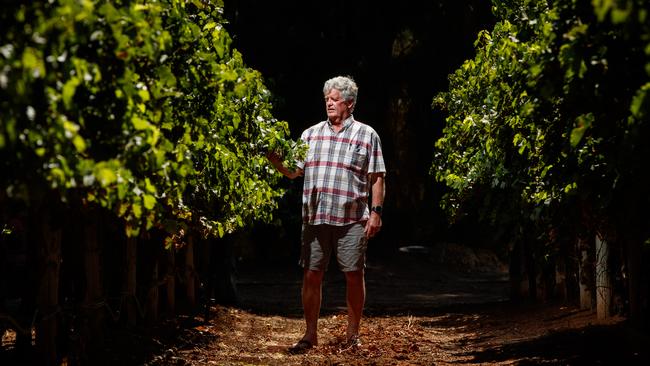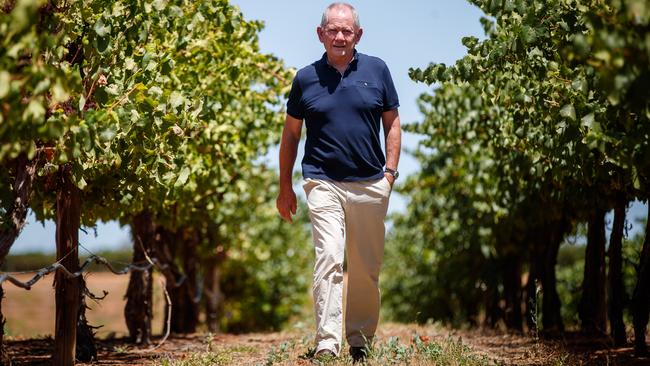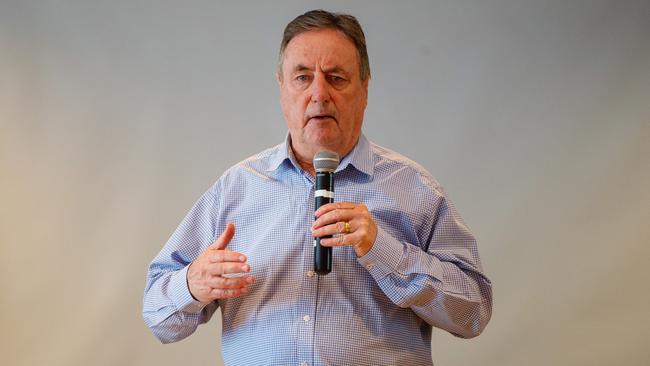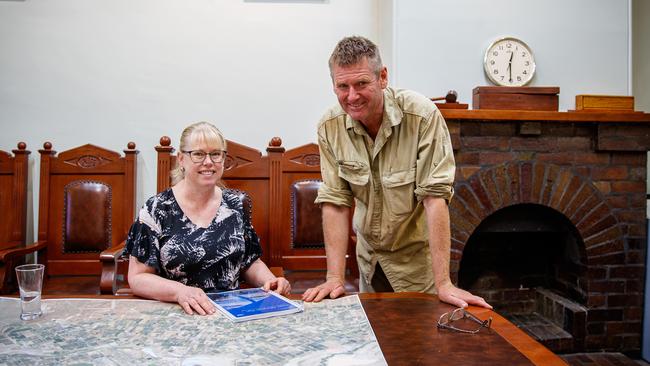Riverland braces for tough 2020 amid high water prices, drought and potential for much smaller allocations
Riverland growers are bracing for a tough year amid high water prices, a drought gripping Australia and the threat of much smaller water allocations this year.

SA Business
Don't miss out on the headlines from SA Business. Followed categories will be added to My News.
- Water watchdog Mick Keelty hears concerns of Renmark growers
- The Advertiser +Rewards – giveaways, offers and competitions
Among the vineyards, fruit packing sheds and almond blocks, Riverland growers are bracing for a tough 2020 as high water prices smash bottom lines and the drought threatens to cut their allocations in half.
But it’s the region itself many are most worried about.
Having weathered the Millennium Drought and seen fellow growers turn off their water or leave the area, they know the impacts of water scarcity all too well.
At Winkie, near Glossop, winegrape irrigator Ian Penno is setting up a new group to advocate for those impacted by the water crisis, to be known as Water Communities SA.
He has spent most of his life in the region, also running a business designing and installing irrigation systems.
The water prices, which nudged $1000 a megalitre last year, are forcing people to make tough decisions about whether they stay in the business, he says, and he’s worried the situation may worsen this year without major rains.

“I don’t want to see my community fall apart,” Mr Penno says.
“Because of the situation now and bad management of the river system, it’s put the price of leasing water through the roof.
“People have been relying on the water market to buy water in. At the moment it’s too dry and it’s going to be potentially dry next (season). So those guys without water are going to potentially walk away.”
Others might choose to stay in the area but have little to spend in shops, pubs, cafes and other local businesses, he says.
The industry landscape in the Riverland comes amid a backdrop of angst upstream. Last year, 2000 angry irrigators protested at Parliament House in Canberra, calling for the Murray-Darling Basin plan to be axed.
Growers – particularly those in NSW – had grown sick of watching water flow past them towards South Australia while they tried to keep their businesses afloat on 0 per cent of their “general security” entitlements.

Some thought their South Australian counterparts were sitting pretty with the ability to use 100 per cent of their entitlements through more expensive, “high security” water licences, which provide full allocations much more frequently.
But they’re not.
Many growers sold their entitlements to the Commonwealth as part of a push to return flows to the ailing Murray-Darling Basin, following years of overextraction.
It means that if they want to water their crops, they must turn to the market and pay sky-high water prices, just like the growers upstream.
Mr Penno’s group was among about 40 people who in January attended a public meeting in Renmark, raising their concerns with water watchdog Mick Keelty, who is investigating the impacts of reduced inflows in the system.
Speaking on behalf of Water Communities SA, Jeff Knispel, of juice manufacturer Nippy’s, said a “Lock Zero” should be considered near Wellington, to reduce freshwater flows to the Lower Lakes and curb evaporation.
It’s an idea that has been called for upstream, but is very unpopular nearer the Murray Mouth, where scientists say flushing the area with seawater would cause an “ecological disaster”.
Environment Minister David Speirs has also rejected the idea.
Mr Keelty has said the “Lock Zero” push, while outside of the scope of his current investigation, should be considered as part of the future work of the Inspector-General’s office.
SA Water Communities also wants a new federal authority to oversee the Murray-Darling Basin Authority to curb issues associated with each state acting in its own interests.
Water prices are now sitting at about $850 a megalitre and over at the Loxton Research Centre, Riverland Wine chairman Chris Byrne says allocations are likely to be “closer to 50 per cent than 100 per cent” this year.

“Driving around, you can see patches that have been turned off,” he says.
“Without those rainfalls we can only dream about, we won’t be on 100 per cent allocations.
“There will be a lot more people in the market for water.”
Winegrape growers would not be able to compete with irrigators of other, higher value crops, such as almonds, he says.
“A lot of people used the Murray-Darling Basin Plan to scale up and relinquished a lot of their water for a business plan that enabled them to in some cases, double their landholdings.”
But, Mr Byrne says the cost of water had gone way beyond anyone’s expectations.
“With the release of indicative prices from some of the major wineries it’s prompted some growers to say that at less than $400 a tonne for chardonnay I can’t afford to grow it. It’d be way letter to lease out the water I’ve got at $700 or $800 a megalitre.”
“If things get any more difficult we’ll see more decisions made by irrigators to stop generating jobs and exports and start working as investors trading the water rights they do have.
“As soon as we start reducing our productivity levels the costs will go up for everyone and consumers will be the big payers.”
Adding to the problem are investors buying up water with no intention of using the allocations themselves, and forcing up the price for growers.

Water can be traded across the basin so there is no guarantee that selling in the Riverland meant the water would be used by another local grower.
There is no easy solution, but Mr Byrne says groups from across the Murray-Darling Basin must work together on ways to build a more sustainable future.
“There needs to be an overall review of land use and water entitlements and a reconciliation of what’s sustainable and what’s not,” he says.
In Renmark, Humphrey Howie, who now grows citrus, grapes, avocadoes and persimmons, says his family has been in the business since the 1890s.
Representing about 600 growers, the presiding member of the Renmark Irrigation Trust says local irrigators feel the pain of their interstate counterparts, after suffering through 18 per cent allocations during 2008/09.
“Realistically, you cannot grow a crop on those allocations and a lot of those members were forced out of the industry,” he tells Mr Keelty.
“Since then we’ve invested in more efficient irrigation infrastructure. We’ve learned from those experiences.
“The blame from interstate hurts a bit.”

Meantime, the trust, which pumps water to those with fruit blocks in the area, is celebrating becoming the first irrigation scheme in the world to be awarded a platinum level certification for its water stewardship.
General manager Rosalie Auricht says the organisation is reviving seven flood plain sites by delivering water – recovered through the Murray Darling Basin Plan ¬ to a series of places which had dried up because of increased pressure on the waterway.
And there are many more environmental projects in the pipeline, with plans to double its environmental projects over the coming years.
“(Those areas) would have received water probably two out of every three years. We’re trying to keep these areas alive,” Ms Auricht says.
“The little bit of water going out onto these flood plains is critical to keep it healthy.”
MORE NEWS
Riverland hailstorm damage bill tallies up to $23m
Multi-day Riverland hiking, cycling trail bid aims to draw in tourists
Riverland growers call for help to make tough water decisions following this week’s hailstorm
She has been in the role for four years, and over that time has seen water prices as low as $20 per megalitre and as high as $975 a megalitre.
“People believe that there’s big investors really playing the market a little bit now and holding back water and keeping the allocation volume on the market low.
“We’re trying to work out in a very complex water market, how can we make sure that our Renmark Irrigation district, which is the oldest in Australia, can continue to survive.
“How can we actually keep that water here, because if people sell their entitlement out of the area, that’s wealth leaving the area. And people running the blocks will always be renters of water.”
TOURISTS, WILDLIFE FLOODING IN
As the sun sets over Banrock Station, wetland manager Tim Field is eager to show off the benefits of environmental flows to the property.
About three quarters of the property was set aside for conservation purposes, with the 1375ha area Ramsar-listed in 2002.
Degraded after many decades of farming, the site has since been rehabilitated and now sees about 60,000 tourists a year.
“In the last eight years we’ve identified nearly 150 different types of flora on the property,” Mr Field says.
“Bird diversity has increased by 30 per cent and we’ve now had over 180 different birds observed on this property, which makes us one of the most bird-diverse sites in SA.”
The landmark is among the 53 sites across SA which last year received water from the Commonwealth Environmental Water Holder.
Some irrigators have called for the amount of water set aside for environmental projects across the basin to be reviewed amid the drought gripping large parts of Australia.
But at the Kingston On Murray property, where frogs call to prospective mates, birds come down to land on the cool waters and a lone kangaroo darts underneath a wetland boardwalk, it’s clear how vital that water is to the health of our landscape.
Among the animals returning to the area are threatened species, including the Regent parrot and southern bell frog.
Mr Field says the water used to flood the area is vital for keeping the area in good health.
The Commonwealth Environmental Water Office says SA has more than 14,000 wetlands, the majority of which require flows of more than 40,000ML per day to remain healthy. However, only about 7000ML flows down the River Murray.
